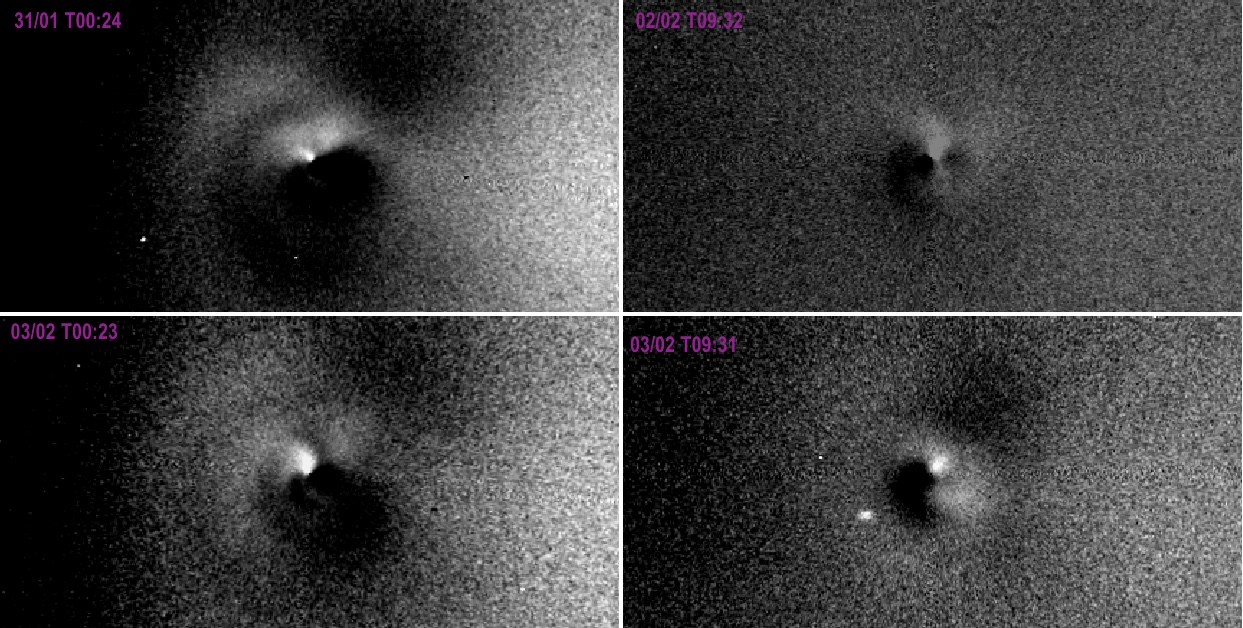Narrowband Observation of Comet C/2006 P1 (McNaught) and Its Rotational Period through Morphological Analysis
- Institute for Astronomy, University of Edinburgh, Edinburgh,UK
The pristine nature of comets offers invaluable insights into the formation and evolution of the early solar system. Examining their morphological features is crucial for understanding their composition, activity, and dynamics. Here we used narrowband imaging to isolate emission lines, image enhancement to improve image contrast, and morphological analysis to investigate the morphological and temporal features of comet C/2006 P1 (McNaught), hereafter C/2006 P1, and its rotational period.
Comet C/2006 P1, renowned the 'Great Comet of 2007' captivated observers worldwide with its brilliant tail during its perihelion at 0.3 AU, particularly fascinating viewers in the Southern Hemisphere after its perihelion. Observing the comet immediately after its perihelion was challenging due to its proximity to the Sun. The advanced capabilities of the European Southern Observatory’s 3.6m New Technology Telescope (NTT), located at La Silla in Chile, were utilized to observe the comet during twilight when it was positioned at a very low elevation angle. Observations commenced on January 27, 2007, 15 days post-perihelion, extending until February 4, reaching the NTT's elevation limit of 10 degrees, with additional observations between February 25 and 28. Using the ESO Multi-Mode Instrument (EMMI), various observations totaling to 210 exposures, including imaging with both broadband (BV R) and 6 narrowband cometary filters, targeting emission lines of CN (386nm), C3 (405nm), C2 (510nm), NH2 (662nm), blue and red dust continuum (441nm and 683nm respectively) as well as spectroscopy. In this work we analyse the narrowband images.
We applied image enhancement methods to enhance the visibility of distinct features such as jets, fans, spirals, and arcs. Various techniques, including subtracting and dividing by azimuthal mean/median profiles, azimuthal renormalization and division by 1/ρ profile were tested and compared. Additionally, rotational filtering and the Larson-Sekanina filter were applied for comparison.
Morphological analysis of the enhanced images obtained through narrowband imaging revealed diverse characteristics within the comet's coma, illustrating the emergence and evolution of these features over time and with rotational orientation. Removal of azimuthal profiles technique, although very sensitive to centering of the nucleus, revealed fainter large-scale features such as spirals, arcs and jets on CN narrowband images. These jets evolve from spirals to arcs during the first observing run and eventually dominate as one or two linear and fan jets by the end of the second observing run.
Generally, subtracting or dividing by the azimuthal median profile does not introduce artifacts, and observing consistent features across tested techniques gives us confidence that the features are real.
Furthermore, periodic repetition of similar coma morphology in CN filters allowed us to constrain the nucleus rotation period. This was done first by dividing each subsequent images by each other to unveil temporal features, and computed their root mean square, RMS to determine the minima ie minima repeats with nucleus rotation. Images taken between 31st January to 4th February, and 25th to 28th February were selected separately, as they provided good but different temporal coverage epochs. Rotation state of the comet's nucleus is discussed.
Figure 1

Figure 2

Figure 1: Shows sample enhanced images of comet C/2006 P1 obtained between January 31 and Febraury 3, 2007 during the first observing run. Using division by azimuthal medium profile, the images reveal spirals, arcs, and linear jets, showing the emergence and evolution of these features as the comet’s nucleus rotates.
Figure 2: Images obtained on February 26-28 during the second observing run were enhanced using the same technique revealing a morphology dominated by linear and fan jets in the comet’s coma.
How to cite: Okoth, V., Snodgrass, C., and Opitom, C.: Narrowband Observation of Comet C/2006 P1 (McNaught) and Its Rotational Period through Morphological Analysis, Europlanet Science Congress 2024, Berlin, Germany, 8–13 Sep 2024, EPSC2024-1001, https://doi.org/10.5194/epsc2024-1001, 2024.